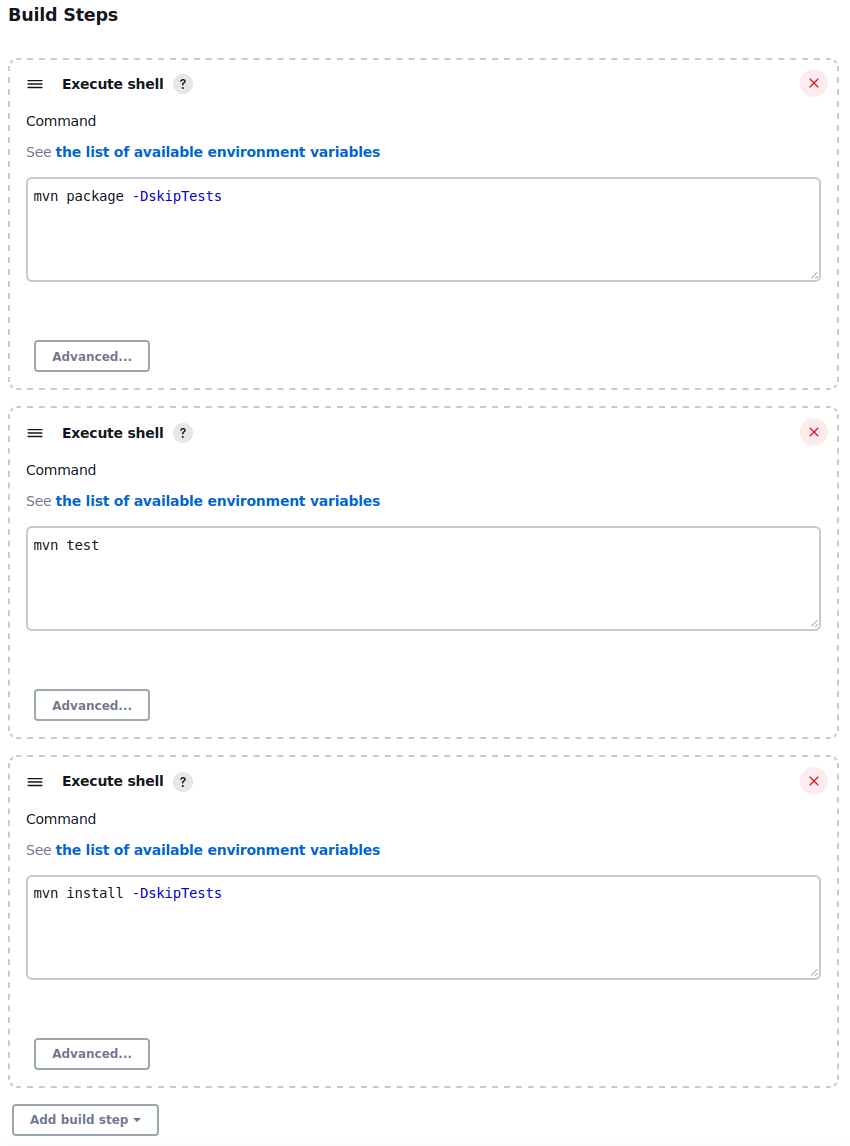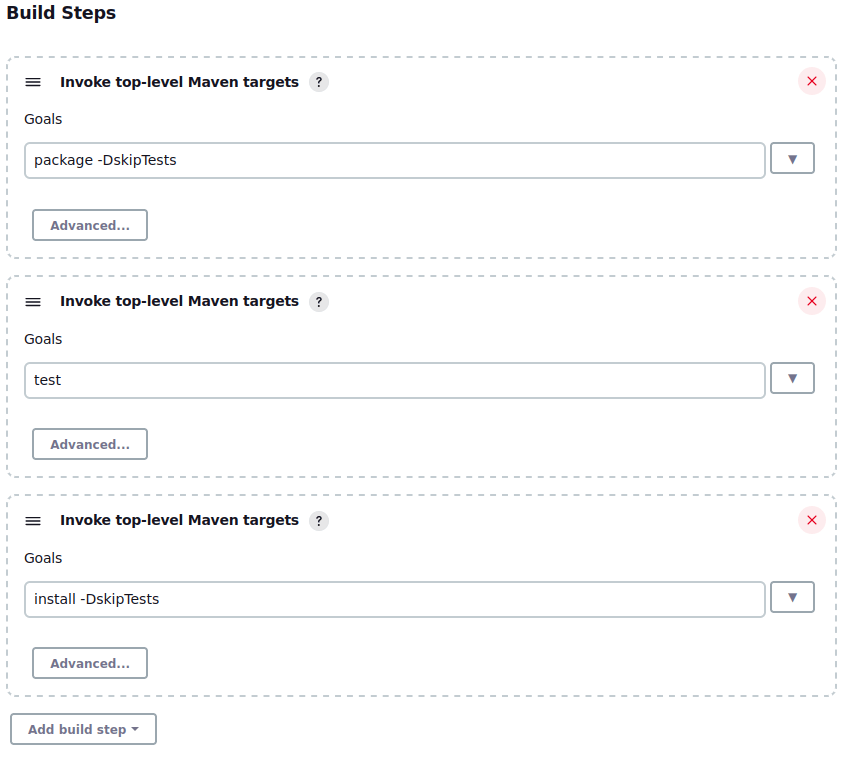Migrate a Maven build from Jenkins to GitLab CI/CD
If you have a Maven build in Jenkins, you can use a Java Spring project template to migrate to GitLab. The template uses Maven for its underlying dependency management.
Sample Jenkins configurations
The following three Jenkins examples each use different methods to test, build, and install a Maven project into a shell agent:
- Freestyle with shell execution
- Freestyle with the Maven task plugin
- A declarative pipeline using a Jenkinsfile
All three examples run the same three commands in order, in three different stages:
-
mvn test: Run any tests found in the codebase -
mvn package -DskipTests: Compile the code into an executable type defined in the POM and skip running any tests because that was done in the first stage. -
mvn install -DskipTests: Install the compiled executable into the agent’s local Maven.m2repository and again skip running the tests.
These examples use a single, persistent Jenkins agent, which requires Maven to be pre-installed on the agent. This method of execution is similar to a GitLab Runner using the shell executor.
Freestyle with shell execution
If using Jenkins’ built-in shell execution option to directly call mvn commands
from the shell on the agent, the configuration might look like:
Freestyle with Maven task plugin
If using the Maven plugin in Jenkins to declare and execute any specific goals in the Maven build lifecycle, the configuration might look like:
This plugin requires Maven to be installed on the Jenkins agent, and uses a script wrapper for calling Maven commands.
Using a declarative pipeline
If using a declarative pipeline, the configuration might look like:
pipeline {
agent any
tools {
maven 'maven-3.6.3'
jdk 'jdk11'
}
stages {
stage('Build') {
steps {
sh "mvn package -DskipTests"
}
}
stage('Test') {
steps {
sh "mvn test"
}
}
stage('Install') {
steps {
sh "mvn install -DskipTests"
}
}
}
}
This example uses shell execution commands instead of plugins.
By default, a declarative pipeline configuration is stored either in the Jenkins
pipeline configuration or directly in the Git repository in a Jenksinfile.
Convert Jenkins configuration to GitLab CI/CD
While the examples above are all slightly different, they can all be migrated to GitLab CI/CD with the same pipeline configuration.
Prerequisites:
- A GitLab Runner with a Shell executor
- Maven 3.6.3 and Java 11 JDK installed on the shell runner
This example mimics the behavior and syntax of building, testing, and installing on Jenkins.
In a GitLab CI/CD pipeline, the commands run in “jobs”, which are grouped into stages.
The migrated configuration in the .gitlab-ci.yml configuration file consists of
two global keywords (stages and variables) followed by 3 jobs:
stages:
- build
- test
- install
variables:
MAVEN_OPTS: >-
-Dhttps.protocols=TLSv1.2
-Dmaven.repo.local=$CI_PROJECT_DIR/.m2/repository
MAVEN_CLI_OPTS: >-
-DskipTests
build-JAR:
stage: build
script:
- mvn $MAVEN_CLI_OPTS package
test-code:
stage: test
script:
- mvn test
install-JAR:
stage: install
script:
- mvn $MAVEN_CLI_OPTS install
In this example:
-
stagesdefines three stages that run in order. Like the Jenkins examples above, the test job runs first, followed by the build job, and finally the install job. -
variablesdefines CI/CD variables that can be used by all jobs:-
MAVEN_OPTSare Maven environment variables needed whenever Maven is executed:-
-Dhttps.protocols=TLSv1.2sets the TLS protocol to version 1.2 for any HTTP requests in the pipeline. -
-Dmaven.repo.local=$CI_PROJECT_DIR/.m2/repositorysets the location of the local Maven repository to the GitLab project directory on the runner, so the job can access and modify the repository.
-
-
MAVEN_CLI_OPTSare specific arguments to be added tomvncommands:-
-DskipTestsskips theteststage in the Maven build lifecycle.
-
-
-
test-code,build-JAR, andinstall-JARare the user-defined names for the jobs to run in the pipeline:-
stagedefines which stage the job runs in. A pipeline contains one or more stages and a stage contains one or more jobs. This example has three stages, each with a single job. -
scriptdefines the commands to run in that job, similar tostepsin aJenkinsfile. Jobs can run multiple commands in sequence, which run in the image container, but in this example the jobs run only one command each.
-
Run jobs in Docker containers
Instead of using a persistent machine for handling this build process like the Jenkins samples, this example uses an ephemeral Docker container to handle execution. Using a container removes the need for maintaining a virtual machine and the Maven version installed on it. It also increases flexibility for expanding and extending the functionality of the pipeline.
Prerequisites:
- A GitLab Runner with the Docker executor that can be used by the project. If you are using GitLab.com, you can use the public instance runners.
This migrated pipeline configuration consists of three global keywords (stages, default, and variables)
followed by 3 jobs. This configuration makes use of additional GitLab CI/CD features
for an improved pipeline compared to the example above:
stages:
- build
- test
- install
default:
image: maven:3.6.3-openjdk-11
cache:
key: $CI_COMMIT_REF_SLUG
paths:
- .m2/
variables:
MAVEN_OPTS: >-
-Dhttps.protocols=TLSv1.2
-Dmaven.repo.local=$CI_PROJECT_DIR/.m2/repository
MAVEN_CLI_OPTS: >-
-DskipTests
build-JAR:
stage: build
script:
- mvn $MAVEN_CLI_OPTS package
test-code:
stage: test
script:
- mvn test
install-JAR:
stage: install
script:
- mvn $MAVEN_CLI_OPTS install
In this example:
-
stagesdefines three stages that run in order. Like the Jenkins examples above, the test job runs first, followed by the build job, and finally the install job. -
defaultdefines standard configuration to reuse in all jobs by default:-
imagedefines the Docker image container to use and execute commands in. In this example, it’s an official Maven Docker image with everything needed already installed. -
cacheis used to cache and reuse dependencies:-
keyis the unique identifier for the specific cache archive. In this example, it’s a shortened version of the Git commit ref, autogenerated as a predefined CI/CD variable. Any job that runs for the same commit ref reuses the same cache. -
pathsare the directories or files to include in the cache. In this example, we cache the.m2/directory to avoid re-installing dependencies between job runs.
-
-
-
variablesdefines CI/CD variables that can be used by all jobs:-
MAVEN_OPTSare Maven environment variables needed whenever Maven is executed:-
-Dhttps.protocols=TLSv1.2sets the TLS protocol to version 1.2 for any HTTP requests in the pipeline. -
-Dmaven.repo.local=$CI_PROJECT_DIR/.m2/repositorysets the location of the local Maven repository to the GitLab project directory on the runner, so the job can access and modify the repository.
-
-
MAVEN_CLI_OPTSare specific arguments to be added tomvncommands:-
-DskipTestsskips theteststage in the Maven build lifecycle.
-
-
-
test-code,build-JAR, andinstall-JARare the user-defined names for the jobs to run in the pipeline:-
stagedefines which stage the job runs in. A pipeline contains one or more stages and a stage contains one or more jobs. This example has three stages, each with a single job. -
scriptdefines the commands to run in that job, similar tostepsin aJenkinsfile. Jobs can run multiple commands in sequence, which run in the image container, but in this example the jobs run only one command each.
-

